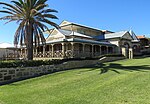Leighton Battery

Leighton Battery at Buckland Hill, Mosman Park, Western Australia, was part of the Coastal defences of Australia during World War II and the Fremantle Fortress, protecting Fremantle Harbour. The battery initially consisted of two 6-inch Mk VII naval guns, operational from February 1943. The two guns were removed in 1945 and replaced by three 5.25 inch dual purpose coastal artillery/antiaircraft guns. While it was envisioned to have all major ports in Australia protected by these type guns, the Leighton Battery became the only one ever operational. The battery was dismantled and the equipment disposed of for scrap in 1963. The battery site was added to the Western Australian State Register of Heritage Places in August 1999 and was awarded an Engineering Heritage National Marker in November 2014. While some above-ground installations have been restored, the underground installations consisting of underground tunnels, rooms, observation post and semi-buried command post are considered an outstanding example of technical achievement.
Excerpt from the Wikipedia article Leighton Battery (License: CC BY-SA 3.0, Authors, Images).Leighton Battery
Poole Place,
Geographical coordinates (GPS) Address Nearby Places Show on map
Geographical coordinates (GPS)
| Latitude | Longitude |
|---|---|
| N -32.017777777778 ° | E 115.75666666667 ° |
Address
Poole Place
6012 , Mosman Park
Western Australia, Australia
Open on Google Maps







